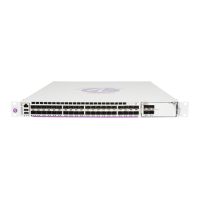Configuring IP Router Parameters
20 7705 SAR OS Router Configuration Guide
Configuring IP Router Parameters
In order to provision services on a 7705 SAR, IP parameters must be configured on the node.
Logical IP routing interfaces must be configured to associate entities, such as a port or the
system, with IP addresses.
A special type of IP interface is the system interface. Configuration of the system interface is
the first step in the provisioning process. When configured, the system IP address can be
advertised via peering or signaling protocols.
A system interface must have a unique IP address with a 32-bit subnet mask (for IPv4) or
128-bit prefix length (for IPv6). The system interface is used as the router identifier by
higher-level protocols such as OSPF, IS-IS, and BGP, unless overwritten by an explicit router
ID.
The following router parameters can be configured:
• Interfaces
• IP Addresses
• Internet Protocol Versions
• Router ID
• Autonomous Systems
• DHCP
• ICMP and ICMPv6
• Static Routes, Dynamic Routes, and ECMP
• IGP-LDP and Static Route-LDP Synchronization
• Bidirectional Forwarding Detection (BFD)
• NAT
Interfaces
The 7705 SAR routers use different types of interfaces for various functions. Interfaces must
be configured with parameters such as the address or port. An interface that is assigned to a
port is a network interface. The system interface is a logical entity and is not assigned to a
physical port.
The 7705 SAR supports IES and VPRN interfaces. IES is used to provide direct forwarding
of IP traffic between CE devices and to facilitate the transport of in-band management traffic
over ATM links. VPRN provides a Layer 3 virtual private network service to end customers.

